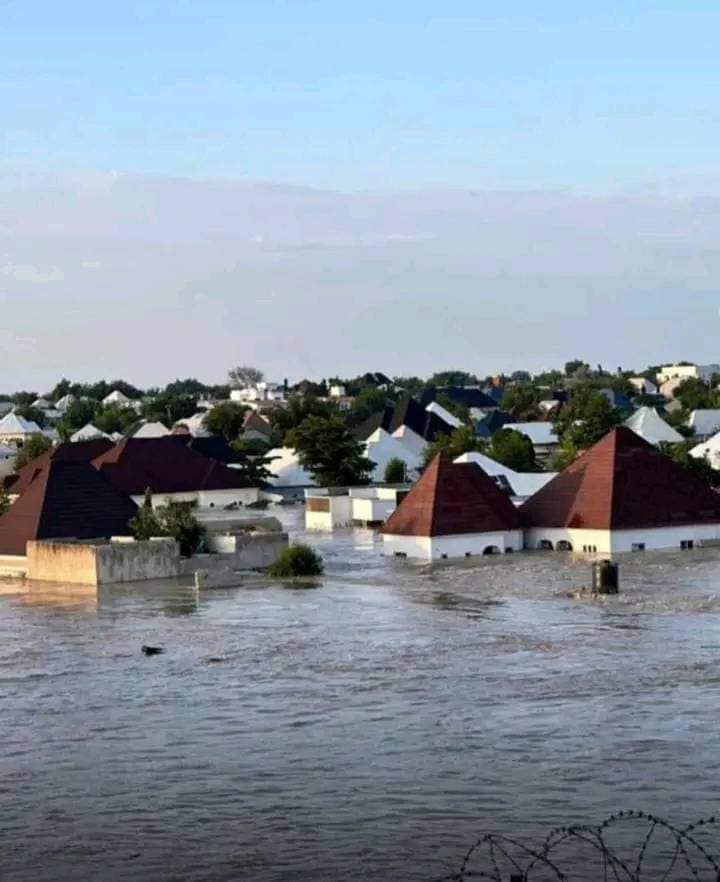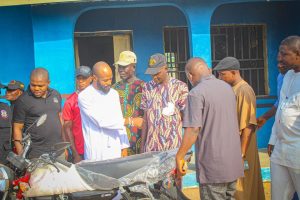ABUJA, NIGERIA – Following a devastating flood in Adamawa State on Sunday that left dozens missing and hundreds displaced, other Nigerian states are intensifying efforts to avert similar catastrophes. The disaster in communities like Shagari Low Cost and Yolde Pate in Yola, the Adamawa State capital, has triggered widespread emergency response efforts across the country.
The torrential rain in Adamawa began around 01:00 and intensified through the early hours of Sunday. By 03:00, homes in the Shagari and Sabon Pegi areas were collapsing as floodwaters surged. Initial reports indicated two fatalities and dozens missing, particularly children, after over six hours of downpour. As of the latest reports, at least eight people have been confirmed dead, including two children swept away in Sabon Pegi whose bodies were recovered by the National Emergency Management Agency (NEMA). In the Ibunu Abbas community, six bodies were recovered, four of whom were bakery workers and two children. The bodies have been deposited at the Moddibo Adamawa Teaching Hospital morgue in Yola.
Abubakar Adamu, a resident of Sabon Pegi, tearfully stated, “Many lives were lost, especially children. We’re still trying to confirm the exact number of casualties.” SP Suleiman Nguroje, the Adamawa State Police Command’s Public Relations Officer, confirmed ongoing search and rescue operations but could not provide a definitive death toll.
Analysis:
The Adamawa floods serve as a stark reminder of Nigeria’s vulnerability to extreme weather events, particularly during the rainy season. Warnings from meteorological agencies about a potentially severe flood season have prompted a nationwide scramble, with states from Anambra and Sokoto to Gombe, Edo, Ogun, and Bayelsa activating flood preparedness plans. This includes clearing drainage channels, assessing dam stability, and intensifying public sensitisation campaigns.
NEMA had previously deployed officials to 15 high-risk states, including Adamawa, last month, following devastating floods in Mokwa that claimed several lives. Dr. Celine Laori, Executive Secretary of the Adamawa State Emergency Management Agency, had also issued a fresh warning last week, urging residents in low-lying communities to relocate.
Across the country, state governments are detailing their preventative measures:
Anambra State: The government has constituted committees headed by the Deputy Governor, Dr. Onyekachi Ibezim, involving various ministries and agencies. Commissioner for Environment, Dr. Felix Odimegwu, highlighted campaigns urging residents to avoid blocking water channels and drainages, which are a primary cause of man-made flooding. Drainages and reservoirs have been upgraded, and NEMA officials are conducting sensitisation programmes in flood-prone local government areas.
Edo State: Ahmed Momoh, Executive Director/CEO of the Edo State Flood, Erosion and Watershed Management Agency, reported ongoing desilting of drains and water passages. Camps have been set up to relocate residents from highly flood-prone areas like Ilushi, Udaba, and Aghenebode, particularly those affected by the River Niger overflowing.
Bayelsa State: Lying six feet below sea level and serving as Nigeria’s flood plain, Bayelsa is particularly vulnerable. The state has cleared natural water channels in Yenagoa and other areas. Walson Omusu, Head of the Bayelsa State Directorate of Flood and Erosion Control, stated the state is “always ready.” Public schools are vacated to serve as IDP camps, and all future public roads are mandated to be raised by an additional 12 inches, a directive from former Governor Senator Seriake Dickson after the 2012 floods.
Sokoto State: Following recent heavy rains, SEMA and NEMA have begun joint impact assessments in the worst-hit local government areas of Yabo, Shagari, and Tureta. Reports detail widespread destruction of homes and farmlands, with poor drainage identified as a key factor in some areas. Temporary shelters have been provided for displaced families.
Imo State: The government, through the Commissioner for Special Duties, Dr. Chika Abazu, held a flood preparedness meeting with disaster management agencies. Technical sub-committees have been formed to handle logistics, health, sanitation, risk communication, and evacuation planning. Coordinated public awareness campaigns and pre-positioning of emergency supplies are underway.
Ogun State: Ogun SEMA has commenced a statewide sensitisation campaign, urging residents, particularly in flood-prone communities, to take proactive measures. Acting Director Soji Durojaye emphasised that indiscriminate dumping of refuse in drainage channels and illegal construction on waterways remain major causes of flooding. Emergency response teams are on alert across all 20 Local Government Areas.
The concerted efforts across various states reflect a heightened awareness and a proactive stance in the face of increasingly severe weather patterns. However, the scale of the challenge, as demonstrated by the Adamawa tragedy, underscores the critical need for sustained investment in infrastructure, urban planning, and public awareness to mitigate the impact of future floods.





Add Comment